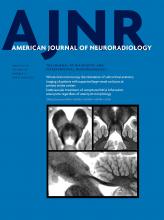Index by author
Fadul, C.E.
- FELLOWS' JOURNAL CLUBAdult BrainYou have accessNeuroimaging-Based Classification Algorithm for Predicting 1p/19q-Codeletion Status in IDH-Mutant Lower Grade GliomasP.P. Batchala, T.J.E. Muttikkal, J.H. Donahue, J.T. Patrie, D. Schiff, C.E. Fadul, E.K. Mrachek, M.-B. Lopes, R. Jain and S.H. PatelAmerican Journal of Neuroradiology March 2019, 40 (3) 426-432; DOI: https://doi.org/10.3174/ajnr.A5957
One hundred two IDH-mutant lower grade gliomas with preoperative MR imaging and known 1p/19q status from The Cancer Genome Atlas composed a training dataset. Two neuroradiologists in consensus analyzed the training dataset for various imaging features: tumor or cyst texture, margins, cortical infiltration, T2-FLAIR mismatch, tumor cyst, T2* susceptibility, hydrocephalus, midline shift, maximum dimension, primary lobe, necrosis, enhancement, edema, and gliomatosis. Statistical analysis of the training data produced a multivariate classification model for codeletion prediction based on a subset of MR imaging features and patient age. Training dataset analysis produced a 2-step classification algorithm with 86.3% codeletion prediction accuracy, based on the following: 1) the presence of the T2-FLAIR mismatch sign, which was 100% predictive of noncodeleted lowergrade gliomas; and 2)a logistic regression model based on texture, patient age, T2* susceptibility, primary lobe, and hydrocephalus. Independent validation ofthe classification algorithm rendered codeletion prediction accuracies of 81.1% and 79.2% in 2 independent readers.
Fahlstrom, M.
- Adult BrainYou have accessAqueductal CSF Stroke Volume Is Increased in Patients with Idiopathic Normal Pressure Hydrocephalus and Decreases after Shunt SurgeryJ. Shanks, K. Markenroth Bloch, K. Laurell, K.G. Cesarini, M. Fahlström, E.-M. Larsson and J. VirhammarAmerican Journal of Neuroradiology March 2019, 40 (3) 453-459; DOI: https://doi.org/10.3174/ajnr.A5972
Faustin, A.
- EDITOR'S CHOICEAdult BrainOpen Access3T MRI Whole-Brain Microscopy Discrimination of Subcortical Anatomy, Part 1: Brain StemM.J. Hoch, M.T. Bruno, A. Faustin, N. Cruz, L. Crandall, T. Wisniewski, O. Devinsky and T.M. ShepherdAmerican Journal of Neuroradiology March 2019, 40 (3) 401-407; DOI: https://doi.org/10.3174/ajnr.A5956
The authors applied an optimized TSE T2 sequence to washed postmortem brain samples to reveal exquisite and reproducible brain stem anatomic MR imaging contrast comparable with histologic atlases. Direct TSE MR imaging sequence discrimination of brain stem anatomy can help validate other MR imaging contrasts, such as diffusion tractography, or serve as a structural template for extracting quantitative MR imaging data in future postmortem investigations.
Fazekas, F.
- Adult BrainOpen AccessQuantitative Susceptibility Mapping to Assess Cerebral Vascular ComplianceC. Birkl, C. Langkammer, P. Sati, C. Enzinger, F. Fazekas and S. RopeleAmerican Journal of Neuroradiology March 2019, 40 (3) 460-463; DOI: https://doi.org/10.3174/ajnr.A5933
Fragata, I.M.R.
- EDITOR'S CHOICEYou have accessImaging of Patients with Suspected Large-Vessel Occlusion at Primary Stroke Centers: Available Modalities and a Suggested ApproachM.A. Almekhlafi, W.G. Kunz, B.K. Menon, R.A. McTaggart, M.V. Jayaraman, B.W. Baxter, D. Heck, D. Frei, C.P. Derdeyn, T. Takagi, A.H. Aamodt, I.M.R. Fragata, M.D. Hill, A.M. Demchuk and M. GoyalAmerican Journal of Neuroradiology March 2019, 40 (3) 396-400; DOI: https://doi.org/10.3174/ajnr.A5971
Endovascular thrombectomy has proven efficacy for a wide range of patients with large-vessel occlusion stroke and in selected cases up to 24 hours from onset. While primary stroke centers have increased the proportion of patients withstroke receiving thrombolytic therapy, delays can be encountereduntil patients with LVO are identified and transferred from the primary stroke center to acomprehensive stroke center. Therefore, any extra steps need to be carefullyweighed. The use of CTA (especially multiphase) at the primary stroke center levelhas many advantages in expediting the transfer of appropriate patients to a comprehensive center.
Frei, D.
- EDITOR'S CHOICEYou have accessImaging of Patients with Suspected Large-Vessel Occlusion at Primary Stroke Centers: Available Modalities and a Suggested ApproachM.A. Almekhlafi, W.G. Kunz, B.K. Menon, R.A. McTaggart, M.V. Jayaraman, B.W. Baxter, D. Heck, D. Frei, C.P. Derdeyn, T. Takagi, A.H. Aamodt, I.M.R. Fragata, M.D. Hill, A.M. Demchuk and M. GoyalAmerican Journal of Neuroradiology March 2019, 40 (3) 396-400; DOI: https://doi.org/10.3174/ajnr.A5971
Endovascular thrombectomy has proven efficacy for a wide range of patients with large-vessel occlusion stroke and in selected cases up to 24 hours from onset. While primary stroke centers have increased the proportion of patients withstroke receiving thrombolytic therapy, delays can be encountereduntil patients with LVO are identified and transferred from the primary stroke center to acomprehensive stroke center. Therefore, any extra steps need to be carefullyweighed. The use of CTA (especially multiphase) at the primary stroke center levelhas many advantages in expediting the transfer of appropriate patients to a comprehensive center.
Frosen, J.
- NeurointerventionOpen AccessLocal Hemodynamic Conditions Associated with Focal Changes in the Intracranial Aneurysm WallJ.R. Cebral, F. Detmer, B.J. Chung, J. Choque-Velasquez, B. Rezai, H. Lehto, R. Tulamo, J. Hernesniemi, M. Niemela, A. Yu, R. Williamson, K. Aziz, S. Sakur, S. Amin-Hanjani, F. Charbel, Y. Tobe, A. Robertson and J. FrösenAmerican Journal of Neuroradiology March 2019, 40 (3) 510-516; DOI: https://doi.org/10.3174/ajnr.A5970
Fujita, A.
- Head and Neck ImagingYou have accessEtiology-Specific Mineralization Patterns in Patients with Labyrinthitis OssificansK. Buch, B. Baylosis, A. Fujita, M.M. Qureshi, K. Takumi, P.C. Weber and O. SakaiAmerican Journal of Neuroradiology March 2019, 40 (3) 551-557; DOI: https://doi.org/10.3174/ajnr.A5985








